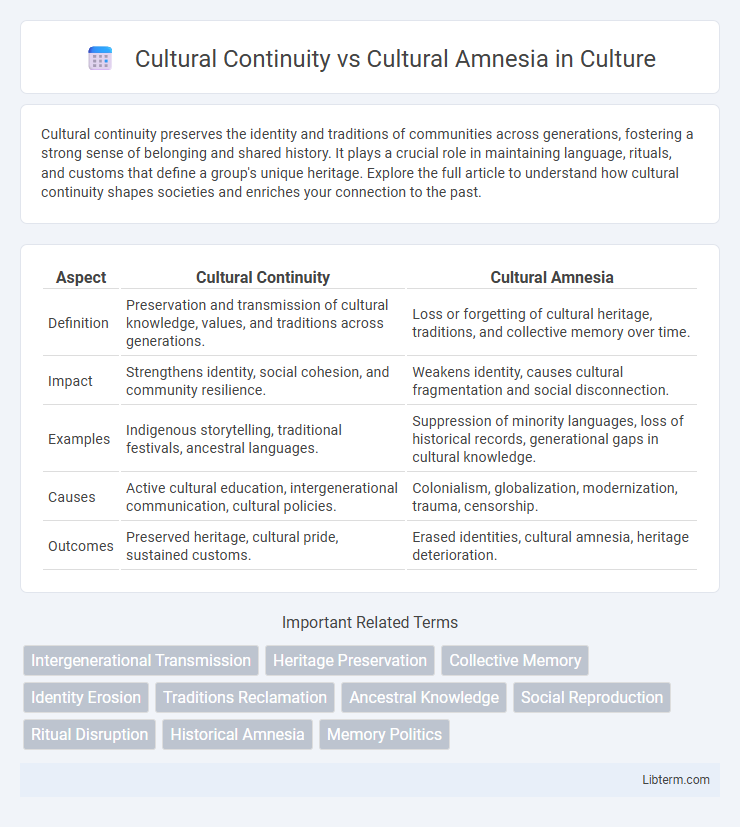Cultural continuity preserves the identity and traditions of communities across generations, fostering a strong sense of belonging and shared history. It plays a crucial role in maintaining language, rituals, and customs that define a group's unique heritage. Explore the full article to understand how cultural continuity shapes societies and enriches your connection to the past.
Table of Comparison
| Aspect | Cultural Continuity | Cultural Amnesia |
|---|---|---|
| Definition | Preservation and transmission of cultural knowledge, values, and traditions across generations. | Loss or forgetting of cultural heritage, traditions, and collective memory over time. |
| Impact | Strengthens identity, social cohesion, and community resilience. | Weakens identity, causes cultural fragmentation and social disconnection. |
| Examples | Indigenous storytelling, traditional festivals, ancestral languages. | Suppression of minority languages, loss of historical records, generational gaps in cultural knowledge. |
| Causes | Active cultural education, intergenerational communication, cultural policies. | Colonialism, globalization, modernization, trauma, censorship. |
| Outcomes | Preserved heritage, cultural pride, sustained customs. | Erased identities, cultural amnesia, heritage deterioration. |
Defining Cultural Continuity and Cultural Amnesia
Cultural continuity refers to the preservation and transmission of traditions, values, language, and customs across generations, ensuring a community's identity remains intact over time. Cultural amnesia describes the loss or suppression of collective memory and historical knowledge, leading to a disconnection from ancestral heritage and cultural roots. Understanding the balance between cultural continuity and cultural amnesia is crucial for maintaining social cohesion and cultural resilience in the face of globalization and modernization.
Historical Roots of Cultural Memory
Cultural memory is deeply rooted in historical events, traditions, and narratives that societies pass down through generations, ensuring cultural continuity. When these memories are preserved, they strengthen collective identity and social cohesion by maintaining a link to ancestors' experiences. Conversely, cultural amnesia occurs when significant historical knowledge is forgotten or suppressed, leading to a fragmented or diminished sense of heritage.
The Role of Oral Traditions in Preserving Culture
Oral traditions serve as vital vessels for cultural continuity, preserving histories, values, and customs across generations without reliance on written records. These spoken narratives, songs, and rituals embed collective memory and identity within communities, counteracting cultural amnesia caused by displacement or external influences. The persistence of oral storytelling ensures that intangible cultural heritage remains dynamic and accessible, maintaining a living link to ancestral knowledge and shared experiences.
Impact of Colonization on Cultural Identity
Colonization has profoundly disrupted cultural continuity, leading to widespread cultural amnesia among indigenous populations as traditional knowledge, languages, and practices were suppressed or erased. The imposition of foreign values and systems undermined native identities, causing a loss of historical memory and communal coherence that still affects descendants today. Reclaiming cultural heritage requires intentional preservation efforts and revitalization of ancestral customs to restore a sense of identity and resilience.
The Influence of Globalization on Cultural Practices
Globalization accelerates cultural exchange, often blending diverse traditions but risking the erosion of unique cultural identities through homogenization. Cultural continuity is maintained when communities actively preserve and adapt their heritage within global frameworks, using technology and transnational networks to reinforce traditional practices. Conversely, cultural amnesia emerges as indigenous knowledge and rituals fade under global cultural dominance, leading to diminished cultural diversity worldwide.
Media and Technology: Bridges or Barriers to Tradition?
Media and technology serve as powerful tools for cultural continuity by preserving and disseminating traditional knowledge through digital archives, storytelling platforms, and virtual museums. However, rapid technological change and mass media often contribute to cultural amnesia by prioritizing globalized content over localized traditions, risking the erosion of unique cultural identities. Balancing innovation with intentional preservation efforts ensures that media and technology act as bridges rather than barriers to cultural heritage.
Education Systems: Preserving or Erasing Heritage?
Education systems play a pivotal role in either preserving cultural continuity or contributing to cultural amnesia by shaping collective identity through curriculum choices and language policies. Incorporating indigenous histories, languages, and traditions fosters cultural preservation and intergenerational transmission of heritage. Conversely, education models that marginalize or exclude minority cultures often lead to cultural erosion and loss of ancestral knowledge.
Case Studies: Cultural Revival Movements
Case studies in cultural revival movements highlight the tension between cultural continuity and cultural amnesia, where communities actively reclaim lost traditions to restore identity and heritage. The Maori Renaissance in New Zealand exemplifies this by revitalizing the Te Reo Maori language and customs after decades of suppression. Similarly, the Celtic Revival in Ireland sparked renewed interest in Gaelic language, folklore, and arts, combating cultural amnesia caused by colonial influence.
Consequences of Cultural Amnesia on Society
Cultural amnesia leads to the erosion of collective identity and weakens social cohesion, as communities lose touch with their historical narratives and traditions. This disruption in cultural transmission diminishes intergenerational understanding and impairs the preservation of language, values, and customs, ultimately causing fragmentation within society. The lack of cultural continuity can result in identity crises, decreased social resilience, and challenges in fostering inclusive, multicultural environments.
Strategies for Sustaining Cultural Continuity
Strategies for sustaining cultural continuity involve preserving traditional practices through community rituals, language revitalization programs, and the documentation of oral histories. Educational initiatives that incorporate indigenous knowledge systems into curricula foster intergenerational transmission and reinforce cultural identity. Collaborative efforts between local communities and cultural institutions ensure the protection of heritage sites and promote active participation in cultural preservation.
Cultural Continuity Infographic

 libterm.com
libterm.com